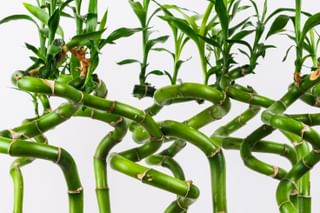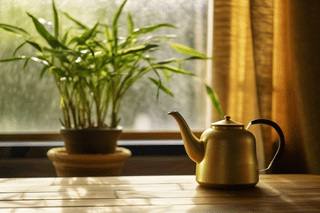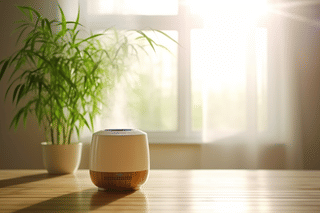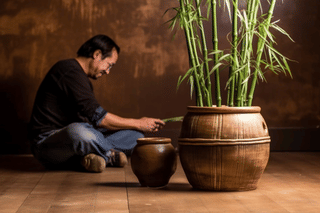How do you take care of bamboo indoors?
Learn the best ways to take care of indoor bamboo plants! Discover simple yet effective tips for maintaining the health and beauty of your bamboo. Gain insights from a plant care expert who will guide you personally. Get ready to create a thriving indoor oasis with your beautiful bamboo!
Ever looked at a bamboo plant sitting gracefully in someone's living room and wondered, "How do they keep it so healthy indoors?" Well, you're not alone! Caring for indoor bamboo plants can feel like it's impossible sometimes, but luckily with a few simple tips, you too can take care of one! I'm here to help!
In this straightforward plant care guide, we'll look at the most important parts of indoor bamboo care. Get ready to learn about the perfect lighting, temperature, watering frequency, and more to keep your bamboo thriving in your home. Bamboo plants can seem high-maintenance, but with our guide, even a plant beginner can have happy bamboo in no time.
These are the topics we're going to look at together:
So, let's embark on this plant care journey, shall we?
Common indoor bamboo species
In the amazing world of houseplants, bamboo is a little special. Unlike most plants, bamboo has a unique blend of strength and flexibility, which is why it's often a sign of resilience and grace in several cultures.
Even if you're a beginner, with the right plant care tips, you can easily grow this beautiful plant indoors. Its adaptability to different light conditions and resistance to pests makes it a great choice for both beginners and more advanced plant parents.
If you've got a bamboo plant already, you might be wondering if this guide will also help you and your specific bamboo species. Let's find out!
Are most indoor bamboo plants similar in care?
There are quite a few different types of bamboo species growing indoors, but luckily their care requirements are all very similar. They all share a love for warm temperatures, indirect light, and well-draining soil.
However, there are small differences related to factors such as water requirement and preferred humidity levels. So it's important to understand the specific needs of your bamboo species. Let's look at a few different species.
-
Lucky Bamboo (Dracaena Sanderiana): Lucky Bamboo is not a true bamboo plant. But it resembles one and is hugely popular due to its feng shui ties and easy care requirements. It's quite tolerant to a wide range of lighting conditions and it prefers having its roots submerged in water instead of being planted in soil.
-
Buddha's Belly Bamboo (Bambusa Ventricosa): This bamboo type gets its name from the swollen, belly-like internodes on its stems. It adapts well indoors and seeks bright light and moderate humidity.
-
Golden Bamboo (Phyllostachys Aurea): A form of running bamboo, these species make a wonderful indoor bamboo screen or a living barrier. However, you'll need to control these runners as they can go wild. They prefer a sunny spot in your house.
-
Moso Bamboo (Phyllostachys Edulis): The largest of the hardy bamboo species, it can reach up to 70 feet in its natural environment. But when you grow them in pots, it stays a lot smaller, perfect for a living room. It thrives in bright light and loves quite a bit of water.
These are just a few of the most common bamboo plants people keep in their homes. Overall, the care requirements of these plants are very similar. Keep these plant-specific guidelines in mind as we go on to look at "general" bamboo care requirements in the rest of this plant care guide.
The best soil for an indoor bamboo
If you've read some of my other plant care guides, it might seem a little strange to see that I'm starting this plant care guide by looking a soil first. But the bamboo plant is a little different than most plants. When it comes to the art of growing and taking care of an indoor bamboo, one question might come to mind: what's the best kind of soil to use?
Does an indoor bamboo need special soil?
Traditional bamboo is a plant that thrives when it's watered very often. Some plants, like the Lucky bamboo, which is actually a dracaena, will even grow in just water. However, unlike most other plants that thrive when they're watered very often, most indoor bamboo plants don't like to sit in moist soil for too long.
The biggest difference between watering the average bamboo and another moisture-loving plant, like the Peace Lily, is the fact that a bamboo needs well-draining soil for its roots to stay healthy.
Indoor bamboo prefers a rich, fast-draining soil. A good mixture could have equal parts of peat, sand, loam or clay. Adding compost or well-rotted manure could give your bamboo a nutritional boost. Coarse sand is also beneficial as it improves drainage. If you're preparing it yourself, maintain a balance between the water-holding and draining capacity of your soil mix to avoid waterlogging or drying out.
Growing an indoor bamboo in LECA
We know that bamboo loves moisture, but also prefers to grow in well-draining soil. If you've heard of Leca before or you've already used it with some plants, you might be wondering if you can grow your bamboo in Leca. Let's find out!
Can you grow a bamboo in LECA?
I get asked if certain plants can grow in Leca quite often, and bamboo is probably the easiest "Yes!" I can give. Growing your bamboo in Leca, or Lightweight Expanded Clay Aggregate, is not only possible, it might actually be easier than growing it in soil.
Leca is a growing medium made of tiny, porous balls of clay, a perfect choice for a bamboo plant. Why? Because it takes away the worries of over-watering or soil diseases that are common with traditional potting compost. This makes any gardener's life quite a bit easier.
The porous nature of Leca balls allows roots to grab onto the structure, while also absorbing and retaining water. This essentially promotes better access to oxygen, leading to a healthier root system and eventually a thriving bamboo plant indoors.
The next section of this plant care guide is about watering a bamboo in soil, so if you're wondering how to water a plant in Leca, have a look at this plant care guide: How to water a plant in Leca.
Watering bamboo indoors
Watering your houseplant is one of the most important things you can do to help your plant thrive. If you water your bamboo correctly, it'll thrive and grow. Water it too much or too little and it could be at risk of death. So let's take out the guessing work and see how we can water bamboo correctly!
How much water does an indoor bamboo need?
Bamboo is a thirsty plant! Generally, it thrives when it has access to moisture all the time. The bamboo, as we've already discovered, also thrives in well-draining soil where the excess moisture drains from the pot quite quickly. This means that the soil will likely dry out after a few days. This is when you need to water it again to keep the soil evenly moist, not wet or dry.
How often should an indoor bamboo be watered?
So after a few days, the soil will start to dry out. The bamboo needs moisture to stay healthy, so you'll likely have to water your bamboo every few days. However, the frequency of watering your indoor bamboo depends on the climate it's in. In warmer conditions, the water evaporates faster, so you should water your plant more frequently. But if your bamboo is in a cooler climate, you can do it less often, around once per week.
When you first get your bamboo, it's a good idea to feel the moisture in the soil with your finger every day to find out how long it takes before the soil dries out. If the top of the soil is dry, you can water it. On the other hand, it's also very important to wait with watering your bamboo if the top of the soil is still moist after a few days.
If the bamboo is sitting in wet soil, root rot can easily happen. Let's have a look at some of the signs your bamboo might show you if you've watered it too much.
What are the signs of too much dater?
Bamboo loves moisture, but you can still overwater the plant. The common signs of overwatering include yellow leaves and stems, and a stench coming from the water, which is a result of rotting roots. If this happens, you should water your plant less often. If you're growing your bamboo in water, make sure to refresh the water and trim any dead and rotting roots.
What are the signs of too little water?
Bamboo plants that aren't getting enough water will show signs like curling leaves, dried-up edges, and a generally dull and lifeless appearance. When you notice this, increase the amount of water, but do it gradually to avoid shocking the plant. Remember, consistent watering is key to a healthy bamboo plant!
Sunlight requirements of an indoor bamboo
Knowing how much sunlight your indoor bamboo needs is critical for its growth and well-being. In this section, we'll look at the sunlight needs of your indoor bamboo plant, and how to recognize signs of too much or too little sunlight exposure.
How much sunlight does an indoor bamboo need?
If the beginning of this post, we've already seen that most bamboo species like bright, indirect sunlight. Some species can tolerate low-light spots and some can stand in direct sunlight for part of the day. Bright, indirect sunlight is a safe medium for all bamboo species, so if you've got a good space like that in your home, this is where you should put your plant.
A spot near a north-facing or east-facing window would be a perfect place for your indoor bamboo plant to soak up the right amount of light. Approximately 6-8 hours of diffused light is optimal, but make sure your plant is not getting too much direct sunlight during the afternoon. Some direct sunlight in the early morning or later afternoon is completely fine though.
What are the signs of too much sunlight?
So how do you recognize the signs if your bamboo has gotten too much sunlight? Too much sunlight can cause damage to your indoor bamboo. So, it's necessary to know the warning signals that your indoor bamboo plant gives when exposed to excessive sunlight. If you notice the leaves turning yellow or brown, or finding burnt marks, it could be signs of overexposure to sunlight. They can also curl and become crispy. If you notice these signs, act quickly by moving your plant to a place with less (direct) sunlight.
What are the signs of too little sunlight?
Just as too much sunlight is harmful, too little exposure to light is also not suitable for your indoor bamboo. The prime indication for this is slow or shriveled growth. If your bamboo leaves are darker in color or if new shoots are long and thin, they might be crying out for more light. In such cases, you should consider moving your bamboo plant to a brighter location.
Temperature and humidity for an indoor bamboo
Your indoor Bamboo plant needs certain things to grow well. A big part of this is having the right temperature and humidity inside. If you get these right, your Bamboo will grow beautifully.
What is the ideal indoor temperature for bamboo?
Bamboo plants generally prefer warmer climates, but they are also pretty adaptable. The ideal indoor temperature for most bamboo plants is typically between 15℃ - 24℃ (60℉ - 75℉).
If you're finding it difficult to maintain a steady temperature within that range, don't panic! Bamboo plants are flexible and can tolerate temperature fluctuations quite well. Just make sure that it's not exposed to freezing temperatures which could harm the plant.
What is the ideal humidity level for bamboo?
Bamboos originate from tropical areas, so they're used to high humidity levels. The optimal humidity level for an indoor bamboo plant is usually between 40% and 50%. Luckily, most homes already have this level of humidity, so you may not have to change a thing.
That said, indoor heating during the cold months can cause the air to get too dry for your bamboo plant. If this happens, you might notice the leaves starting to turn brown or curl inward. In such a case, misting the leaves with water or using a humidifier will help keep the plant hydrated and happy.
Remember, every plant is unique and may react differently to the conditions in your home, so it's always a good idea to observe your plant and adapt your care routine accordingly. After all, giving your indoor bamboo the right conditions to thrive is the secret to having a long-lasting, beautiful plant.
Fertilizing an indoor bamboo
If you've created the ideal growing environment for your bamboo, you're ready to take your plant care to the next level by fertilizing your plant regularly. To keep your bamboo healthy, vigorous, and looking its best, you need to feed it with fertilizer. Fertilizer provides essential nutrients that can improve its color and promote growth. But how do you do it? What kind and how often should we apply it?
How often should you fertilize a bamboo?
Fertilizing your bamboo plant isn't an everyday thing: you should only do it once at the beginning of spring and once at the beginning of the summer. This is the time of year when your bamboo will have its growth spurts and when it'll need the extra nutrients.
During the fall and winter, you won't need to fertilize your bamboo at all as it'll likely go dormant and won't grow very much.
If you're not quite sure how much fertilizer to use, start with a weak, diluted solution. You can slowly keep increasing the dosage if you notice the plant is growing well during the spring and summer.
Remember, over-fertilizing can do more harm than good. It might create a hard, crusty surface around the pot, preventing water from correctly soaking into the soil. Plus, it could burn the roots, damaging the plant.
What is the best type of fertilizer for bamboo?
Choosing a suitable fertilizer for your indoor bamboo is necessary for its growth and development. You can commonly find three types of fertilizer on the market: granular, liquid, and spikes. But bamboo plants, in general, prefer a balanced, water-soluble fertilizer. This type of fertilizer makes sure that the nutrients get distributed evenly throughout the pot.
A balanced fertilizer means equal parts nitrogen (N), phosphorus (P), and potassium (K). Usually, they are represented by a number ratio of 20-20-20. This balance of the different ingredients will feed your indoor bamboo properly. Nitrogen enhances leaf growth, phosphorus is good for root and shoot development, and potassium is important for the overall health of the plant.
If you see any yellowing or browning leaves, it may be a sign of over-fertilization. If this happens, give your bamboo plant a good flush of water to help remove excess fertilizer, then adjust your schedule or the amount accordingly. If your plant's growth seems stunted, it could be a sign it needs more food, so re-evaluate your fertilizing plan.
The ideal pot size for an indoor bamboo
When it comes to growing lush, healthy bamboo plants inside your home, one crucial factor to consider is the size of the pot you choose for your plant.
What is the ideal pot size for a bamboo?
Choosing the right pot size for your indoor bamboo plant isn't as complicated as it might seem. Bamboo plants are pretty adaptable and can thrive in most conditions. However, the ideal pot size for most bamboo plants is about 5 cm (2 inches) larger on all sides of your plant's root mass. This will give your bamboo plenty of room to grow and expand, but won't make the plant so large that you risk overwatering your bamboo.
How often should bamboo be repotted?
How often you should repot your indoor bamboo depends on how fast it's growing. Some bamboo types grow faster than others, so there's no set repotting schedule that applies to all bamboo. But I'll give you some guidelines.
As a general rule, young bamboo or those that are growing rapidly need to be repotted every year. But once your bamboo has matured, repotting every two to three years is usually plenty.
But how do you know when it's time to repot? If your bamboo plant seems to be struggling or if you see roots extending out of the pot's bottom, that's a clear sign your plant needs a new home.
Common pests on bamboo plants
Bamboo plants are very tough plants, but just like any other plants, can attract quite a few bugs and pests. It is important to identify any pests properly so that you can protect your bamboo from harm. In this part of the guide, we are going to learn about the common pests that love to feast on bamboo and how you can prevent them.
What are common pests on bamboo?
Bamboo plants are often attractive to numerous types of pests. However, a few of these pests are more common than others. Some of the most frequent ones are:
-
Aphids: These tiny, soft-bodied insects suck the sap from bamboo plants, causing the leaves to turn yellow and curled. If left unchecked, they can cause severe damage. Aphids also excrete a sticky substance, known as honeydew, which can attract other pests.
-
Mealybugs: These are small, white, and fluffy-looking pests that are relatively easy to spot. Similar to aphids, they suck the sap out of the plant, leading to yellowing or curling of the leaves.
-
Spider mites: These tiny, spider-like pests can be difficult to see with the naked eye. Spider mites can cause a bamboo plant's leaves to discolor and may lead to leaf drop if not treated.
How can you prevent pests on a bamboo?
Keeping your bamboo plant healthy and free from pests doesn't have to be hard work. Here are some simple but effective strategies you can use:
The best way to prevent pests on your houseplant is to take excellent care of your plant. The healthier your bamboo, the less likely it is to attract pests. Make sure your bamboo gets the right amount of water and sunlight and is planted in well-draining soil.
Even if you take great care of your bamboo, you should regularly inspect your bamboo plant for signs of pests. Look for things like discolored leaves, tiny webs, or small, moving spots.
As a preventive measure, you should also make sure to keep the area around your bamboo plant clean. Debris can attract pests, so make sure you keep it to a minimum.
And last but not least, you can use a natural pesticide like Neem Oil if pests do show up on your bamboo. It can kill pests without damaging your plant.
Thank you for reading this post! I hope it helps you to keep your plants healthy and beautiful! If you're looking for more guides on specific plants, you can always request a plant guide to get a guide for the plant you have trouble with.
Test your plant care knowledge
Quiz completed!
Want to learn more? Sign up for my newsletter to receive free tips in your inbox!
Sign up now!












